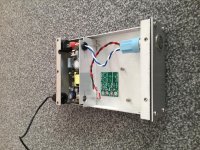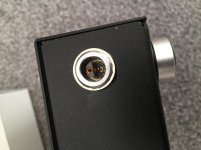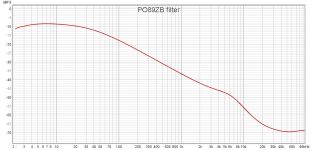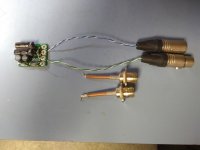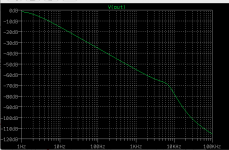When one does not have the ability to build PSU's at all one nowadays buys a ready made SMPS. This is also preventing messing with mains stuff to the beginners and thus safer. It is not one the best of choices in audio though. When one does know how to build a quality linear PSU that is shortest path to best results indeed.
BTW the answer was to built the PO89ZB IN the devices when these have SMPS adapters/wall warts. Why making more mediocre connections with 2.1 or 2.5 mm connectors than necessary? When built in there will be just 1 x 2.1/2.5 mm connector as the bare minimum which is good. When the device has built in SMPS the PO89ZB can be put in between as well.
Think of the 2.2/2.5 mm connector as "best avoided unless absolutely necessary".
BTW the answer was to built the PO89ZB IN the devices when these have SMPS adapters/wall warts. Why making more mediocre connections with 2.1 or 2.5 mm connectors than necessary? When built in there will be just 1 x 2.1/2.5 mm connector as the bare minimum which is good. When the device has built in SMPS the PO89ZB can be put in between as well.
Think of the 2.2/2.5 mm connector as "best avoided unless absolutely necessary".
Last edited:
Here my second implementation but this time some of the parts are out of stock. This will be probably one of the last attempts with SMPS for my sources. All the well built (but factors more expensive) linear PSU's win by a margin but one must keep an open eye and do some experimenting IMO. In a previous one the PO89ZB was a good improvement.
As a better connector I tend to use Lemo whenever I can. These are mechanically and electrically very well designed. These do have a retention mechanism which is often omitted with cheap connectors.
As a better connector I tend to use Lemo whenever I can. These are mechanically and electrically very well designed. These do have a retention mechanism which is often omitted with cheap connectors.
Attachments
Last edited:
Oscillation
The filter cleans up every aspect of the sound with the SMPS, sound stage more defined, and it is like a veil has been lifted.
With the UBiB it is the same but on a much more subtle level. The noise is measurable, but only just with my skills.
Strangelly enough, the filter seems to reduce some of the soft edges of the Nutube, sharpening the sound and bringing out subtle details on instruments
The filter cleans up every aspect of the sound with the SMPS, sound stage more defined, and it is like a veil has been lifted.
With the UBiB it is the same but on a much more subtle level. The noise is measurable, but only just with my skills.
Strangelly enough, the filter seems to reduce some of the soft edges of the Nutube, sharpening the sound and bringing out subtle details on instruments
Last edited:
It seems that a low noise PSU is a worthwhile improvement  This is of course a well known fact and we had a slogan long ago: a device is as good as its power supply. A straight thin line on our measurement gear is what we call good, amongst some other parameters. Using something noisy is not good and it calls for measures.... but those will be band aids for noise created earlier in the chain. If this is a system choice then we fixed the drawbacks.
This is of course a well known fact and we had a slogan long ago: a device is as good as its power supply. A straight thin line on our measurement gear is what we call good, amongst some other parameters. Using something noisy is not good and it calls for measures.... but those will be band aids for noise created earlier in the chain. If this is a system choice then we fixed the drawbacks.
@konst: it surprises me as UltraBib is supposed to be ultra low noise already. Without wanting negative criticism (I don't use these ultraBiB so I don't know them) : any good quality DC power supply for audio devices must have very low noise to be called "good". If a linear PSU is not ultra allow noise in a pretty wide bandwidth area it is better checked and when noisy by design it is likely not suitable for high quality audio (with or without veils ), regardless of the PSRR of the circuit in question.
), regardless of the PSRR of the circuit in question.
@konst: it surprises me as UltraBib is supposed to be ultra low noise already. Without wanting negative criticism (I don't use these ultraBiB so I don't know them) : any good quality DC power supply for audio devices must have very low noise to be called "good". If a linear PSU is not ultra allow noise in a pretty wide bandwidth area it is better checked and when noisy by design it is likely not suitable for high quality audio (with or without veils
Last edited:
Hi,
Is it me who is tired, or is that an odd result?
I know that real life differs a bit from the theory due to things not being perfect, but...
Given the layout, I would have expected 2 identical LC low pass filters in serial. That is in total 24dB/octave filtering slope and a unique Fc around 5kHz.
Here I see rather a 6dB slope (1st order filter) starting at perhaps 40Hz and possibly another 6dB/octave filter (making a total 12dB/octave slope) starting around 7kHz.
Odd?
Claude
Is it me who is tired, or is that an odd result?
I know that real life differs a bit from the theory due to things not being perfect, but...
Given the layout, I would have expected 2 identical LC low pass filters in serial. That is in total 24dB/octave filtering slope and a unique Fc around 5kHz.
Here I see rather a 6dB slope (1st order filter) starting at perhaps 40Hz and possibly another 6dB/octave filter (making a total 12dB/octave slope) starting around 7kHz.
Odd?
Claude
Yes agree it is odd, I wasn't paying much attention to the low frequency response but after posting started thinking about it. I think it may have to do with the output and input impedance of the audio DAC/ADC and possibly the reverse polarity zener. R4 is there and the coils are Murata 13R22C not the ones from the BOM - they are backordered.Is it me who is tired, or is that an odd result?
Sorry for the bad results, just ignore them - I'm experimenting and measuring a power filter is new territory for me.
This week I'm shipping the prototype of a 48 volt, 6 amp version which DOES have PCB mounting holes that fall on 1.00 centimeter gridlines. DC series resistance is less than 40 milliohms so it ought to be suitable for Raspberry Pi applications and sub-40-watts-per-channel Class A amplifier applications like the First Watt amps. If the early adopters like what they hear, I'll publish the Gerbers. If not then it never happened.
Hi, what should I modify to get, say, a version that can work up to 72 or 96 V?
Roberto
So this pesky Bourns inductor is still out of stock, can anyone recommend a replacement, how about this https://www.mouser.co.uk/ProductDetail/652-RLB9012-2R2ML/ ?
Here is a possible variant of the PO89ZB inline DC filter for SMPS. This is a 3 stage version and the inductor has a 8.2A current rating. Everything is in stock at Mouser.
An externally hosted image should be here but it was not working when we last tested it.
An externally hosted image should be here but it was not working when we last tested it.
An externally hosted image should be here but it was not working when we last tested it.
- Home
- Source & Line
- Analog Line Level
- PO89ZB , an inline DC filter for SMPS wall warts . Preamps, HPA, Korg NuTube, etc
